Bogotà, Cusco, Machu Picchu, Lima -- March-April 2014
photos by G.P. Jones using Nikon Coolpix 4300 digital
camera, except where noted
Bogotá, Colombia - 20-25 March

SCROLL TO RIGHT (or widen browser) to see entire wall
The story of Bogotá, for me, is the story of graffiti and street art. The slogan at the right says, "My vote isn't trash."
Oh, by the way, this group of mostly unsigtly scrawling is found on the main façade of the Cathedral . . .

. . . which, from a distance, looks pretty respectable.

Graffiti appears everywhere in Bogotá, even on what would later be sirloin (if it weren't just a statue).

This is artistic, in every sense of the word, no doubt working on many levels that are beyond me.

I'm guessing this string of images is unrelated, embellished over time by different artists.

Some graffiti is really street art, perhaps even commissioned by the city and paid for. This appears to be a bit more planned than some of the other images you would see around town.

I can't be sure of this one. The meaning of the words is ambiguous: "[It is] prohibited to scratch [perhaps in the sense of cross out or remove?], to put up posters, and to forget."

The grinning, one-eyed heads near the right are seen on many walls around the City.

Serious? Even ominous? Seems so, but the message (if any?) isn't clear to me.

At the left of the artwork shown just above is this stencilled warning, which seems to lay out the laws relevant to marking or painting public walls. Is this, itself, some graffiti? I didn't see it anywhere else in town.

This dragon has a head and body on one building, with a tail on the building behind. This is great stuff!

Graffiti? Street art? Company logo? Whatever it is, it is not just painted on. but some kind of plastic or metal piece affixed to the wall.

Here, without question, is an example of street art. The artist is chalking his work on the street itself (Carrera 7). Most of this central avenue is "peatonal", closed to traffic to accomodate pedestrian shopping and strolling.

Through the magic of PhotoShop (and the courtesy of the artist to stand up for a break in his work), I've turned the image around for convenient viewing and so that you can read the meaningful slogan he's written at the bottom: "Bogotà is not like they paint her." (At least that's how I read it!)
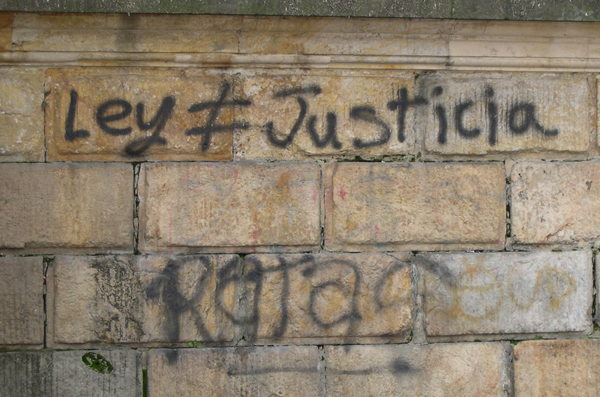
There is no question how to read this slogan: "Law isn't equal to Justice" (or, "The law isn't necessarily fair")

The National Capitol, apparently undergoing some repairs or renovations.

Along Carrera 7 the Church of San Francisco, built between 1557 and 1621 then rebuilt after the 1785 earthquake, looks much as it probably did two hundred years ago.

Unlike most important churches in the City, here we can see the very building blocks of the walls.

The interior of this church is remarkable in several ways. (Photographs are not allowed inside, so I have to rely on the information kiosk out front to illustrate this point.) The main altar takes up about 1/3 of the length of the church, and is covered with gold, not only in front, but all along both side walls and the ceiling. To the right of the altar is a chapel, about the same length as the altar itself, which is lined with huge oil paintings, at least twenty or more in all. The wealth in art works alone in the Churches in these large South American capitals must be staggering.

Bugs Bonny. OK.

The sign on the "Fat Guy's Bar" features a pig and Oliver Hardy. (How rude!)

Colpatria Bank was running an ad campaign all over town tied to soccer mania (presumably because of the upcoming World Cup). This poor dog looks like he'd rather be elsewhere.

Ahhh, the T-Shirts of Bogotà. Notice how many have parodies of Homer Simpson -- Homer as Superman, as Einstein, and . . . see below.

Homero Sapiens. Of course. Award for the year's best use of a fig leaf.
_5.jpg)
Che Homero (this one was found in Lima, but who's counting?)

And Homer as "El Señor de los Anillos" -- "The Lord of the Rings"

This shirt contains an image I learned a lot more about later, a comic-book character called Memín Pingüín. It intrigued me because it looked so much like the caricatures of black people (and/or monkeys) found in very early XXth-Century Hollywood cartoons.

A sharp eye located one of the actual comic books (seen here on the left) on display outside a shop, and later I found a trove of various issues in a used-book store near my hotel. I asked the owner if the character was a monkey, perhaps the pet of the three boys in the cover image on the left. No, he told me, he's a boy himself, a black boy. This astounding portrayal of stereotype continued, the store owner told me, until the mid-1980s. I began to realise, as you'll see again when we get to Perú (below), that these images are by no means a thing of the past in South America.

The Monday I was in Colombia was a national holiday, Día de San José. Carrera 7 was jammed with people, food and noise. They had disinfected the street two nights before (an awful smell that even the Bogotaners were noticing), and now it all made sense.

The proprieter of this street cart selling guanabana juice either got up very early, or had some free time available to make this grasshopper out of leaves.

The sign on this empty cart seemed awful strange to me. Steamed Dog, super or not, just didn't seem possible this side of Hong Kong. It took me a couple of days to figure out that it's just Hot Dogs they're selling.

Instituto Colombiano para el Fomento de la Educación Superior (whew!), across from the Parque de los Periodistas (newspapermen)

The wavy tile roof of the Casa del Rio restaurant, across from the Parque de los Periodistas

Not a vendor, not a rolling party. It's just a taxi with a bunch of balloons attached.

Civic engineering at its most economical. Why take out the tracks? Just put in the sidewalk, and be done with it.

This church, Nuestra Señora de las Nieves (Our Lady of Snows) was founded in 1585, but the building looks a bit more modern than that.

The interior of Our Lady of Snows matches the exterior, an unusual consistency in church architecture.
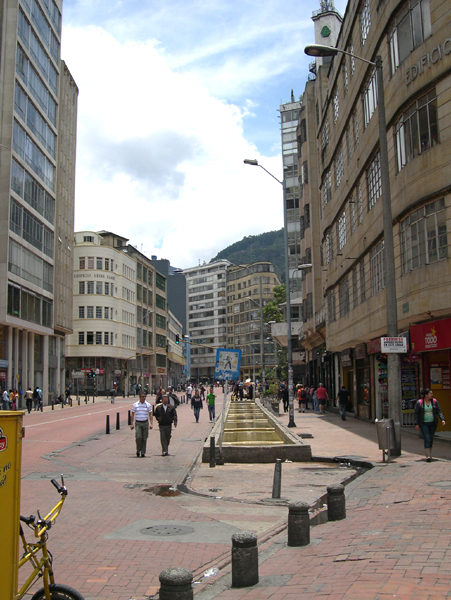
This is the bottom portion of a remarkable fountain that begins almost a mile up the hill. Each rectangular pool empties into the one just below it, and when it comes to a cross street, it sort of goes underground, reappearing on the other side.

The top of this fountain is much better maintained than the lower portions.

This weekend, with the San José holiday, was a special one for a very holy icon normally seen at the Monserrate Sanctuary (see below). Once a year, the figure known as El Señor Caído (The Fallen Lord) is taken down the hill from Monserrate, and displayed for the weekend in the City's Cathedral. The statue can be seen in this announcement, posted throughout the city, informing people not to go to Monserrate if they want to see it. This icon is so highly regarded that uniformed soldiers of the Presidential Guard stand by it as the faithful pay their respects.

The Cerro de Monserrate (Monserrate mountain) rises to 3,152 metres (10,341 ft), dominating the City below.

At the top of Monserrate is a church, begun in 1620. It is reached either by funicular (train cars on tracks) or by teleférico (enclosed gondolas suspended from cables). Both modes of transportation run continuously all day.

Naturally, the view from Cerro de Monserrate is dramatic.

This close-up shows the area of downtown where my hotel was located, quite convenient to everything that interested me, and nowhere near a Starbucks!

Like most venues on this holiday weekend, the grounds of Monserrate were jammed. The food, by the way, in the joints up the hill was very, very good.

From Monserrate one can look over to the next peak, atop of which stands a small chapel and a 15-metre-high statue of Nuestra Señora de Guadalupe, with outstretched arms.

This is obviously Bogotá's answer to the Cristo Redentor in Rio de Janeiro, and apparently many cities in South America have put up similar copies -- I mean tributes! (see Cusco below). This one dates to 1946.

The city has a pretty good public transportation system, with the major routes served by these Transmilenio vehicles. What you're looking at here is one bus! It's quite literally half a block long.
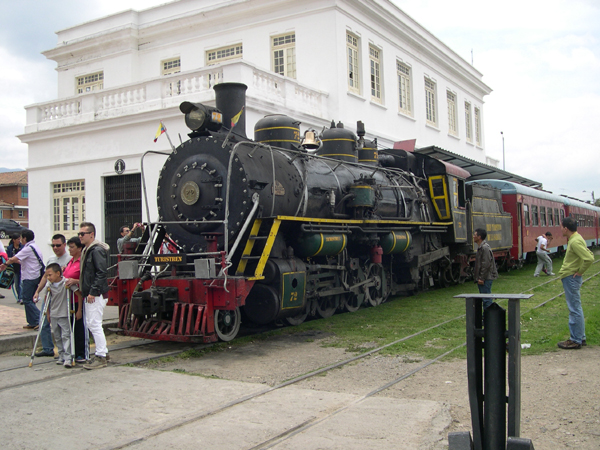
Bogotá apparently has only one passenger train left, the so-called Tren Turistico which runs on weekends and holidays to the town of Cajicá, about 39 km North of Bogotá.

On Saturdays they pull the train with a modern engine, but on Sundays, they use a real, vintage steam engine, spewing smoke everywhere, including the passenger cars' open windows. At one point, we passed by a field where some teens were playing soccer, and half of them were pulling up their shirts to shield their noses and mouths from the fumes. All along the route people were waving and taking pictures. At one point we passed some guys who were working along the route, maintaining the tracks and cutting away grass, and some of them even stopped to take pictures with their cell-phone cameras.

Cajicá is a very small town, with an unremarkable Church, but an unusual sign inside. It reminds people not to mark on the pews, nor stick gum to them, nor to put their feet on the kneeling-benches. The last line is priceless: "Let's educate ourselves, already!"

This (presumably) silver altar-piece in Cajicá's Iglesia de la Immaculada Concepción caught my attention, because of the inscription "J H S" in the center. Either it's a stylized version of the common Christian initials "I H S" (In Hoc Signo), or JHS means something else, or it's just a mistake. I did see it, however, in several other churches in Bogotá and Lima.

Despite the smoke from the train, some of the views through elegant, suburban Bogotá on the way back were quite nice.

Then, just before returning to the Estación Sabana to end the journey, the train goes through some rough, urban landscape, and I saw this graffito on a wall. I laughed out loud, thinking at first that it was just a shot at Bogotá in general: "If Christ died for you, why do you live here?"
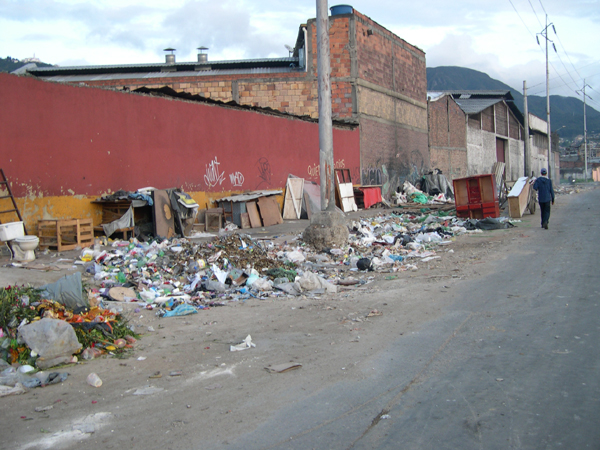
When I went back (on foot) to find the wall so I could photograph the scrawl, I sobered up pretty quickly. The saying was on a wall right in the middle of this God-forsaken homeless encampment.

Obviously, "Why do you live here" means why, despite Christ's sacrifice, are you homeless?

At El Dorado Airport, while waiting for the flight to Lima, I noticed an interesting ritual on the tarmac below. A man with a clipboard was making the rounds to all the ground employees (well, all the men, anyway). He would shake their hand, have them sign a paper on the clipboard, pat them down, and then shake their hand again. How civilised!
Cusco, Perú - 26-28 March

Here we go again, with the Cristo knockoffs, this time in Cusco.

The Cusceños call theirs El Cristo Blanco (The White Christ). The town's elevation, by the way, is about 3,400 metres (11,200 feet) above sea level. That means the statue on the hill is even higher.

Raffting by car? Not in my car, thank you.

SEMI-PANORAMA -- SCROLL TO RIGHT (or enlarge your browser) to see the whole picture
The central square in Cusco is the Plaza de Armas. It has to be the about the highest concentration of major churches in any city of Cusco's size anywhere. On the square itself there is the Cathedral (left), and the Iglesia de la Compañia de Jesús (right). Within three or four blocks around this square are at least six other large Churches, all lavishly furnished and quite well maintained (Cusco is a rich tourist town, after all).

Since photography wasn't allowed in the Cathedral (or any Cuscozian Churches), I took this photo from the window of the Cathedral's men's room.

Speaking of the "facilities", South Americans use a variety of terms for the Servicios Hygienicos (SS.HH.), including some I hadn't seen before, such as "Varones" (Barons). The hand-made sign was, I think, as much a joke as anything -- but it was a welcome sight, nonetheless.

One finds this curious statue in front of the Colegio Nacional de Ciencias.

Outside the Convent of Santo Domingo Qorikancha this decorated cross stands as yet another reminder of the deeply religious basis of this culture.

A small, free art exhibit in a Cusco storefront had this delightful comment on XXth-Century painting styles. (I learned in March 2016 that this is Picasso, Dalí y el huevo, by Spanish artist David Vela Cervera [born 1967]. Neither the title nor the name of the artist was posted at the Cusco store.)

South America, like most of the world, is warming up to Pope Francis very quickly, and understandably so, as he's South American (Argentine) himself. One wonders if this is an authorized poster, with the Pope's actual words, or . . . well, probably not. It's remarkably colloquial: "Hey you, on the cell-phone, turn it off, you're at Mass." You go, Pope!
Machu Picchu - 27 March (day trip)

The centerpiece of this trip for me was the trip to Machu Picchu. Here, the bus leaves Cusco in the early morning.

The journey took about 3-1/2 hours, and consisted of a bimodal service -- bus from Cusco's Estación Wanchaq to Estación Pachar, then a Perurail train through spectacular canyons along the Urubamba River to Estación de Machu Picchu in the small town of Aguas Calientes.

The station where bus changed to train was situated in a deep canyon, with rock cliffs that would probably dwarf anything in Yosemite in California or Zion in Utah. One cliff, seen here, had three (seemingly) tiny structures perched about 2/3 of the way up. The best I could get out of one of the train employees was that these were, in fact, dwellings, but not homes -- they may be way-stations for hikers. The guide used the word "deportes" (sports) in describing them, so that's all I could get.

The trains are pretty modern, and comfortable.

The scenery on the route along the rushing, sometimes violent Urubamba river rivalled anything I've ever seen from a train, including the much-hyped Copper Canyon train in México (see previous trip), and the spectacular ride through British Columbia (see May 2008 trip, this Web page). After arriving at the end of the train line (Aguas Calientes), we boarded busses again for the switchback climb into the clouds and the Lost City of the Incas.

As for Machu Picchu itself, there is only one way to describe it: say nothing. It is one of those places in the world -- others, in my experience, have been the Pantheon in Rome, and Hagia Sofia in Istanbul -- where one is grateful for the hordes of rude and inconsiderate tourists, because without them the experience of being there would just be overwhelming. So, I will let the place (or images of it) speak for itself.




PANORAMA - SCROLL TO RIGHT (or enlarge your browser) for the full view

An unusual stone "ring". Most of Machu Picchu is just walls and terraces made from building blocks.
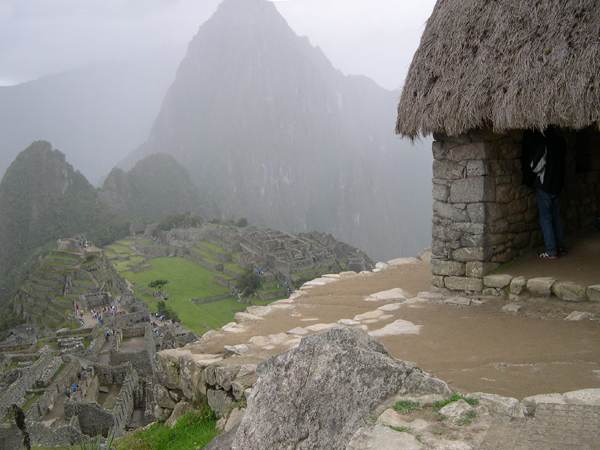




Flora.

More flora.

Fauna. (Either llamas or alpacas -- I can't tell the difference.)

Have you heard the joke caption for this typical tourist picture? "Going to Machu Picchu? Alpaca bag."

The Intihuatana Stone, where the sun is moored. According to Dr Ernesto 'Che' Guevara (yes, that Che Guevara) who wrote of his visits to Machu Picchu, this stone represents one of only a few such pieces remaining, since the Spaniards usually destroyed this symbol whenever they encountered an Inca Fortress. ("Machu-Picchu, enigma de piedra en América", Siete, 12 December 1953.)

The Temple of the Condor, because of the unusual natural markings in the rock that reminded the Incas of that bird.
Lima, Perú - 29 March-2 April

Back to earth, I'm now in Jorge Chávez Airport in Lima. Here's another black stereotype, way beyond Aunt Jemima I think, like those noted above in the Memín comics. Imagine this fast-food store, as you see it here, in Chicago O'Hare or JFK airport in New York!

Lima Contra El Ruido. Well, it's a nice sentiment -- Lima Against Noise -- but as I took this picture from the taxi, we were in a traffic jam where apparently no-one had time to read the sign!

Lotsa elegant buildings in Lima, very colonial.

A few whimsical structures, as well, like this parfait façade near the Plaza Mayor.

The Museo del Arte Italiano is a small venue -- just five exhibit rooms -- but the building is unique. The illustrations on either side of the main door are mosaics.

Knock Knock. Who's There? (you finish it as you please)

Every time I went into a Church in Lima, the furnishings and decorations topped the one before. This, in the Iglesia San Pedro, is a Retablo (basically a side-altar) to the left of the main altar. I'd estimate it's 40 feet high, or more, and there are eight of them, four on each side of the church, each different from the others, and each quite ornate.

This is a small part of another 40-foot Retablo, this completely carved of dark, polished wood. This Retablo had no indication of its dedication or when it was constructed, but most of the others in this church were dated from the XVIIth Century, which is when the Church was consecrated. That means this angel probably has been there as long as White people have been settled in North America. Humbling, eh?

Lima's balconies are famous enough that there is a poster sold around town showing various examples.
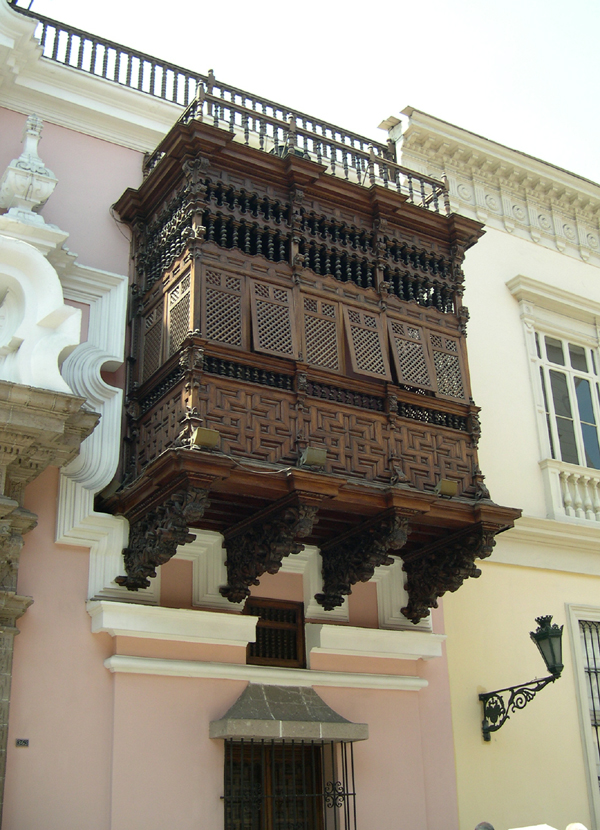
The detailed wood-work on many of these balconies is quite elegant.

Well, like the ship sailing away in the picture, we leave Lima to return home. This actually is a mosaic, unusual in a chapel-niche in a Church, in Lima's Cathedral, watching over the tomb of Francisco Pizarro. The presence of this tomb in such an honoured place is unusual, considering that the brutal Pizarro took Lima by force, later to be murdered there by the son of one of his rivals. Perhaps even topping that is the fact that, until 1977 the glass casket in the chapel/tomb contained the bones of a man that wasn't even Pizarro! This was discovered when some men working on the church's foundation found another casket labeled as being Pizarro's remains, later verified by forensic experts. Adiós for now, Lima.